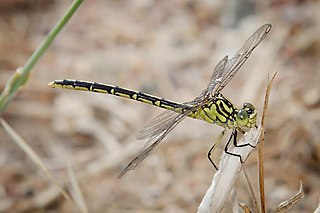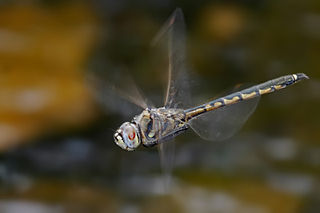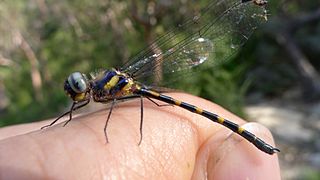
Argiocnemis is a genus of damselfly in the family Coenagrionidae. Species of Argiocnemis are generally small to medium-sized damselflies, darkly coloured with pale markings. They occur in Africa, Indian Ocean islands, South-east Asia, New Guinea and Australia.

Austrogomphus is a genus of dragonflies in the family Gomphidae, endemic to Australia. Species of Austrogomphus are tiny to medium-sized dragonflies, black in colour with yellowish markings. They are commonly known as hunters.

Ceriagrion is a genus of damselfly in the family Coenagrionidae. Species of Ceriagrion are small to medium size, generally brightly coloured damselflies. They are found across the Old World, Africa, Asia and Australia.

Hemicordulia is a genus of dragonfly in family Corduliidae. It occurs in Africa, southern Asia, Australasia and Pacific Islands such as the Bonin Islands, Fiji and French Polynesia. Species of Hemicordulia are small to medium-sized dragonflies, coloured black or metallic, with yellow.

Ictinogomphus is a genus of dragonflies in either the family Gomphidae or Lindeniidae. They are medium to large, yellow and black with clear wings. Species occur in Africa, Asia and Australia.

Rhinocypha is a genus of damselflies in the family Chlorocyphidae.

Tetrathemis is a genus of dragonflies in the family Libellulidae. Species of Tetrathemis are found in Africa, Madagascar, Asia, New Guinea and Australia.

The red and blue damsel is a damselfly in the family Coenagrionidae. It is the only member of the monotypic genus Xanthagrion.

Diphlebia is a genus of damselflies in the family Lestoideidae. They are commonly known as rockmasters. These damselflies are very large and thick. The species in this genus are found in Eastern Australia, except for one species that can be found in New Guinea. The males are vividly patterned. They are blue or bluish green and black in colour. Their blue colour also gives them the name azure damselflies. They rest with their wings spread out. Their wings are usually blackish brown or have white markings. These damselflies have several present antenodal crossveins. The two basal crossveins extend across costal and subcostal spaces. The larvae are wide and flat. They have long saccoid gills enabling them to breathe underwater. The inner tooth of their labial palps is elongated. The specific characters of the larva are mid-ventral, distal width, basal width, and length of median lobe.

Rhodothemis is a genus of dragonflies in the family Libellulidae. The species occur from India, through Southeast Asia to Australia.

Nannophlebia is a genus of dragonfly in the family Libellulidae. They are commonly known as Archtails. The species are very small with black and yellow striped abdomens.

Nososticta is a genus of damselfly in the family Platycnemididae. It has a wide range from Africa, through Indonesia to Australia. They are commonly known as Threadtails.

Cordulephya is a genus of dragonflies in the family Cordulephyidae, endemic to eastern Australia. The species are small to tiny in size, coloured black, or purplish-black, with yellowish markings. Unusually for Anisoptera, these dragonflies rest with their wings folded above their body in a similar manner to many species of damselfly. They are commonly known as shutwings.

Hemigomphus is a genus of dragonflies in the family Gomphidae, endemic to Australia. The species are small with black and yellow markings. They are commonly known as vicetails.

Telephlebia is a genus of dragonflies in the family Telephlebiidae, endemic to eastern Australia. Species of Telephlebia are medium to large, dark chestnut brown dragonflies with dark markings on the leading edge of their wings. They are crepuscular and fly at dusk.

Synlestes is a genus of damselflies in the family Synlestidae. Species of Synlestes are very large damselflies, metallic green to dark bronze or black in colour with white, yellow or orange markings. Unlike many other damselflies, they spread their wings when resting. They are endemic to eastern Australia where they inhabit streams.

Neurobasis australis is a species of damselfly in the family Calopterygidae, commonly known as a Papuan demoiselle. It is a large, metallic green damselfly with long legs, and dark wings without pterostigma. It has been recorded from New Guinea, and Indonesia, where it inhabits streams.

Diphlebia lestoides is a species of Australian damselfly in the family Lestoideidae, commonly known as a whitewater rockmaster. It is endemic to south-eastern Australia, where it inhabits streams and rivers.

Calopteryginae is a subfamily of broad-winged damselflies in the family Calopterygidae. There are about 17 genera and more than 160 described species in Calopteryginae.

Euphaea is a genus of damselflies in the family Euphaeidae. There are more than 30 described species in Euphaea, found mainly in Indomalaya.























